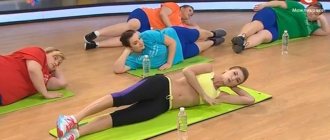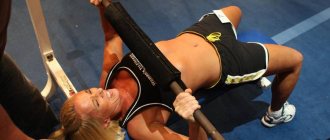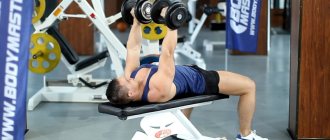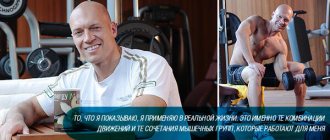Both beginners and experienced athletes are concerned about how to create the right training program. It is the consistent execution of a pre-compiled program that will allow you to achieve results. Unsystematic training, as a rule, ends in disappointment - there are no results, the motivation to exercise disappears.
Key points when creating a training program:
- training goal
- training frequency
- duration of training
- order of training different muscle groups
- choice of exercises
Training frequency
How often to train and how many times a week to train each muscle group?
All muscle groups can be divided into large (back, legs, chest) and small (biceps, shoulders, triceps, calves).
Large muscles take longer to recover after training than small ones, so they are trained less frequently, usually once a week (split training). However, beginners may not yet be able to train at the same intensity as more experienced athletes. They won't be able to work their muscles as well.
Therefore, beginners are recommended to work out all muscle groups during each training session, performing basic exercises, and go to the gym 3-4 times a week (example of a basic program). As your preparation increases, you can switch to split training - 3 times a week, each time you work out one large muscle group and 1-2 small ones.
All of the above is suitable for both those who are gaining muscle mass and those who want to lose weight. But to burn fat, you need to add either 1-2 more cardio workouts per week, or switch to high-repetition training - a large number of repetitions, short rest times between sets, light weights. You can also incorporate circuit training into your plan.
What muscles can you train on the same day as your shoulders? For gaining muscle mass
According to sports medicine recommendations, strength training should be performed at least twice a week. During this time, you will develop the main muscle groups: chest, back, shoulders, biceps, triceps, abs, anterior and posterior thigh muscles.
Remember that 48 hours of rest is necessary for any muscle recovery. Do not forget that to gain weight you need to pay attention to high-quality protein nutrition and appropriate caloric intake.
What to train with in the gym to gain weight? You should not load a large number of muscles at the same time, but the muscles involved should work to their maximum, if possible without affecting another large muscle group.
In this case, the body will specifically restore certain areas without wasting building material to bring the entire body back to normal.
Training opposing muscle groups is one of the most common types of strength training. At the same time, in one session they do exercises on antagonistic muscles, which ensure the movement of joints in opposite directions. Simply put, you work on the front and back of a specific area of the body on the same day.
Since you will need rest for the stressed muscles, it is convenient to train on a different part of the body the next day.
Advantages of this method:
- The target muscle group works to the maximum. You won't be able to achieve the same effect by training your whole body at once. By focusing on a different area each time, you will get results faster.
- Research shows that you engage muscle fibers more actively when you work or at least stretch antagonist muscles in the same session. This means that the chest press will be more effective after the mid-back stretch.
- Training antagonistic muscles ensures that you work both sides of the body evenly, maintaining a balanced development of the figure.
The disadvantages of this type of training include the fact that you will only work each muscle group once a week. Sample schedule for four workouts per week:
- Monday: chest and back.
- Tuesday: anterior and posterior thigh muscles, abs.
- Thursday: biceps, triceps and shoulders.
- Saturday: chest and back.
Next Monday, do thigh and abdominal exercises and continue the rotation further.
Another option for targeted muscle loading is to divide large muscle groups by day. Thus, one day you train the chest and triceps, the next day - the back and biceps, the next workout - the legs and shoulders.
The shoulders can be worked together with the pectoral muscles. This method of training is also convenient for a busy training plan.
Keep in mind that to improve performance and relieve stress on the nervous system, the training strategy must be periodically changed. For example, do exercises for the biceps together with the pectoral muscles, and the back with the triceps. This will diversify your workouts, relieve psychological fatigue and give impetus to further gain muscle mass.
Duration of training and rest between sets
On average, strength training lasts 45-90 minutes. The lower your fitness level, the longer each workout lasts. The heavier the weights and the fewer reps you do, the shorter the workout will be. Accordingly, strength training will be shorter than fat burning and endurance training. Read more in the article How long should a workout last?
Rest between sets is also directly related to your goals - for mass and strength gains, the rest is slightly longer (about 60 seconds, maximum 90) than for fat loss (45-60 seconds). Rest between exercises for about 90 seconds. Also, when performing isolation exercises (on machines) and exercises for small muscle groups, rest should be reduced by 15-30 seconds.
Abs on leg day?
A reader asks: Is it possible to do abs on leg day?
An interesting question... In the sense that I myself have never thought about this in my life, nor have I heard it from others. Why did such a question even arise? However, since the question has been asked, let's speculate...
Leg days are different. The main thing we want to know is whether free weight squats will be used. The bottom line is this: Squats load the spine, and protecting the spine from overload is the abdominal muscles. Yes, that’s right, although ordinary people who don’t know anatomy think that squats work the back muscles. By the way, pulling a barbell from a platform or from a hanging position is also largely provided by the abdominal muscles. And in these cases, it is possible and necessary to pump up the abs BEFORE squats, but only as a warm-up exercise - you shouldn’t pump up the abs “to the point of melting”, because later, during squats, injury to the spine and hamstrings is possible.
So, with squats, we “killed” the core muscles - after this, do we need to additionally “finish off” them with abdominal exercises? Well, it’s up to whoever wants it and who has how much time and energy remains...
It’s another matter if “leg day” is provided, for example, by a leg press in a machine or isolated leg extension – here the press works very indirectly, and the spine is not loaded. In fact, we don’t care whether the core muscles are exhausted or not. Perhaps in this case they can be loaded both before and after...
Oh, by the way, one more nuance... The ever-memorable “gluteal bridge”... For some reason everyone thinks that this is an exercise for the buttocks. Some people attribute to it the fame of an exercise for developing the abs. Alas, neither the abs nor the buttocks can be developed with a “glute bridge”, contrary to the name. At the same time, this is a very important exercise for warming up the piriformis muscles. It is the spasm of the “pear” that provides us with the pain that we call “sciatica”. It is not the injury to the lumbar spine, but the injury to the piriformis muscle that causes this pain! In squats and deadlifts, when carrying bags and rolling carts in the country, if the gluteal muscle is not strong enough, and if the abs are not developed enough, or if lifting a heavy object is carried out asymmetrically, the relatively weak “pear” takes the blow and... locks in spasm. That’s sciatica for you, grandma... Therefore, on “leg day” before squats, you need to “turn on” the piriformis muscles - welcome to the “glute bridge”.
Well, one last thing: the abs can be pumped up in such a way that nothing but injury will develop. And, judging by my observations, this is exactly how most ordinary people pump up their abs. Perhaps the next article should be devoted to this issue...
The order of training different muscle groups and the selection of exercises
For beginners, it is recommended to work the entire body in each workout to improve overall fitness. Start with heavy basic exercises (Squats, Deadlifts, Presses), and end with isolation exercises (biceps, triceps, abs, etc. exercises). You can alternate workouts for the lower body (legs) and upper body (back and chest). At the very beginning, there is almost no point in pumping your arms with separate exercises - biceps, triceps, deltoids are perfectly worked out in basic exercises.
Try to do more exercises with barbells and dumbbells and a minimum of exercises. The exercise machines are intended primarily for those who, due to injuries or other health problems, cannot fully exercise with barbells and dumbbells. Trainers are also used by experienced bodybuilders when they need to work out lagging muscles in isolation. For beginners, exercises with free weights will give the best effect.
After 6-12 months, you can train in a split - each time attention is paid to one large muscle group and 1-2 small ones. There should be one rest day between training days to allow muscle recovery.
Which muscle groups are best trained together and in what order to create a proper split training program? For example, you train 3 times a week - Monday, Wednesday, Friday. On Monday, when you have the most energy, train the muscle group that is hardest for you to train, or the muscle group that is lagging behind. Most often these are the legs. Start with the base - squats, Romanian deadlifts, lunges. Afterwards, you can do leg flexion/extension exercises on the machine.
At the end, do abdominal exercises if you have any strength left. On the day of chest training, first you perform barbell and dumbbell presses at different angles, push-ups from the floor/on parallel bars, and dumbbell flyes. After triceps and deltoids exercises. On the day of back training, first do deadlifts, barbell rows, and pull-ups. You can alternate between dumbbell rows and block rows. At the end, add biceps exercises.
How to pump up your pectoral muscles
Work on the pectoral muscles.
Experts do not recommend doing more than two chest workouts per week. For beginner athletes, it is enough to perform 2 exercises of 2-3 approaches each. For more advanced athletes, it is optimal to do 6-8 repetitions to increase strength, and 10-12 to build muscle mass.
Advice! Almost all exercises for chest training include the work of the triceps, so when creating a training program. Exercises for the pectoral muscles and triceps should be done on different days.
Let's look at some basic exercises to build up the pectoral muscles:
- Bench press. It is considered the best exercise for beginner athletes. The main advantage is the ability to pump different areas of the chest by changing the inclination of the bench (positive tilt - pumps the upper chest, tilting your head down - pumps the lower area). The number of approaches depends on the training program and on average is 3-4 approaches. You need to do 6-12 repetitions.
Execution technique. Take your starting position on the bench: you need to lie down, pressing your buttocks, shoulders and head to the surface, place your feet on the floor, placing them shoulder-width apart. Take the barbell with a wide grip and lift it up above the center of your chest.
Advice! Be sure to enlist the support of your partner to insure you at first.
We also recommend studying this topic:
How to properly pump up your pectoral muscles: a technique from professionals
14598 0 0
As you inhale, lower the barbell down until it lightly touches your chest, hold your breath. As you exhale, lift the barbell up and hold it in this position, straining your pectoral muscles as much as possible. The barbell should be lowered slowly and raised at a moderate or fast pace.
Performing a bench press.
- Dips. When performing this exercise, most of the muscles of the body are involved in the work: chest-biceps, muscles of the back and shoulder girdle, arms and abdominal muscles of the press.
Execution technique: Take the starting position on the uneven bars with your arms outstretched. This position contracts the muscles and prepares them for stress. You need to tilt your torso forward and slowly lower yourself down while inhaling. After a pause, straightening your arms, as you exhale, slowly rise up. To avoid creating the risk of injury to the elbow joint or pectoral muscle, chest-biceps training should be done slowly.
Important! Watch the position of your elbows: they should be spread out to the sides. Keep them away from your ribs while lifting. This will increase the effect of the exercise.
Performing push-ups on parallel bars.
When performing this exercise in the gym, you should adjust the number of approaches depending on the program. On average, perform 2-3 approaches 6-10 times. Keep in mind that you can only engage the pectoral muscles by going deeply down when performing the exercise. Otherwise, the chest muscles will be used only partially, the triceps will work mainly.
We also recommend studying this topic:
Breast lift using fitness at home
10982 0 1
Readers found these materials useful:
- Push-ups for the upper and lower pectoral muscles
- How to pump up your chest with a barbell: a set of exercises for quick results











